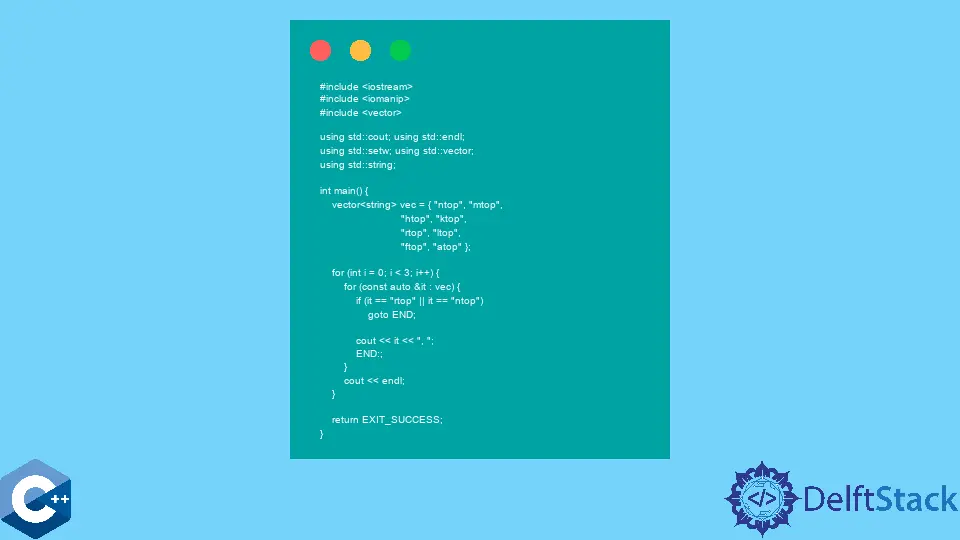The continue Statement in C++

This article will explain how to utilize the continue statement in C++.
Use the continue Statement to Skip the Remaining Portion of the Loop Body
The continue statement is utilized in conjunction with iteration statements to manipulate the loop-dependent block execution. Namely, once the continue statement is reached in the loop, the following statements are skipped over, and the control moves to the condition evaluation step. If the condition is true, the loop starts from a new iteration cycle as usual.
Note that continue can only be included in a code block enclosed by at least one of the loop statements: for, while, do...while, or range-based for. Suppose we have multiple nested loops, and the continue statement is included in the inner one. The skipping behavior affects only the inner loop while the outer one behaves as usual.
In the following example, we demonstrate two for loops, the inner of which iterates through the vector of strings. Notice that the continue statement is specified at the beginning of the loop body, and it essentially controls if the following statement gets executed. Thus, the string values with rtop and ntop are not displayed on output, and the outer loop executes all of its cycles.
#include <iomanip>
#include <iostream>
#include <vector>
using std::cout;
using std::endl;
using std::setw;
using std::string;
using std::vector;
int main() {
vector<string> vec = {"ntop", "mtop", "htop", "ktop",
"rtop", "ltop", "ftop", "atop"};
for (int i = 0; i < 3; i++) {
for (const auto &it : vec) {
if (it == "rtop" || it == "ntop") continue;
cout << it << ", ";
}
cout << endl;
}
return EXIT_SUCCESS;
}
Output:
mtop, htop, ktop, ltop, ftop, atop,
mtop, htop, ktop, ltop, ftop, atop,
mtop, htop, ktop, ltop, ftop, atop,
Alternatively, we can implement the same behavior of the previous code snippet using the goto statement instead of continue. Remember that goto acts as an unconditional jump to the given line in the program, and it should not be used to jump over variable initialization statements. In this case, the empty statement can be marked with the END label so that goto will move the execution to the given label.
#include <iomanip>
#include <iostream>
#include <vector>
using std::cout;
using std::endl;
using std::setw;
using std::string;
using std::vector;
int main() {
vector<string> vec = {"ntop", "mtop", "htop", "ktop",
"rtop", "ltop", "ftop", "atop"};
for (int i = 0; i < 3; i++) {
for (const auto &it : vec) {
if (it == "rtop" || it == "ntop") goto END;
cout << it << ", ";
END:;
}
cout << endl;
}
return EXIT_SUCCESS;
}
The continue statement can be considered bad practice by some coding guidelines, making the code a bit harder to read. The same recommendation is often given to excessive usage of goto statements. Still, one can utilize these constructs when the given problem can internalize the readability cost and offer easier implementation using these statements. The next code example shows the basic usage of the continue statement in a while loop.
#include <iomanip>
#include <iostream>
#include <vector>
using std::cout;
using std::endl;
using std::setw;
using std::string;
using std::vector;
int main() {
vector<string> vec = {"ntop", "mtop", "htop", "ktop",
"rtop", "ltop", "ftop", "atop"};
while (!vec.empty()) {
if (vec.back() == "atop") {
vec.pop_back();
continue;
}
cout << vec.back() << ", ";
vec.pop_back();
}
cout << "\nsize = " << vec.size() << endl;
return EXIT_SUCCESS;
}
Output:
ftop, ltop, rtop, ktop, htop, mtop, ntop,
size = 0
Founder of DelftStack.com. Jinku has worked in the robotics and automotive industries for over 8 years. He sharpened his coding skills when he needed to do the automatic testing, data collection from remote servers and report creation from the endurance test. He is from an electrical/electronics engineering background but has expanded his interest to embedded electronics, embedded programming and front-/back-end programming.
LinkedIn Facebook